Related Research Articles

Gerard David was an Early Netherlandish painter and manuscript illuminator known for his brilliant use of color. Only a bare outline of his life survives, although some facts are known. He may have been the Meester gheraet van brugghe who became a master of the Antwerp guild in 1515. He was very successful in his lifetime and probably ran two workshops, in Antwerp and Bruges. Like many painters of his period, his reputation diminished in the 17th century until he was rediscovered in the 19th century.

The Limbourg brothers were Dutch miniature painters from the city of Nijmegen. They were active in the early 15th century in France and Burgundy, working in the International Gothic style.
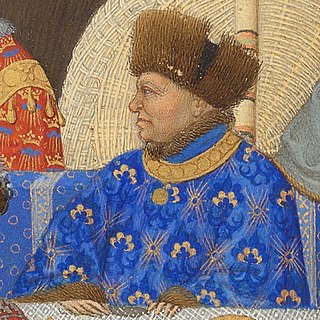
John of Berry or John the Magnificent was Duke of Berry and Auvergne and Count of Poitiers and Montpensier. His brothers were King Charles V of France, Duke Louis I of Anjou and Duke Philip the Bold of Burgundy. He was Regent of France from 1380 to 1388 during the minority of his nephew Charles VI.

Early Netherlandish painting is the body of work by artists active in the Burgundian and Habsburg Netherlands during the 15th- and 16th-century Northern Renaissance period, once known as the Flemish Primitives. It flourished especially in the cities of Bruges, Ghent, Mechelen, Leuven, Tournai and Brussels, all in present-day Belgium. The period begins approximately with Robert Campin and Jan van Eyck in the 1420s and lasts at least until the death of Gerard David in 1523, although many scholars extend it to the start of the Dutch Revolt in 1566 or 1568–Max J. Friedländer's acclaimed surveys run through Pieter Bruegel the Elder. Early Netherlandish painting coincides with the Early and High Italian Renaissance, but the early period is seen as an independent artistic evolution, separate from the Renaissance humanism that characterised developments in Italy. Beginning in the 1490s, as increasing numbers of Netherlandish and other Northern painters traveled to Italy, Renaissance ideals and painting styles were incorporated into northern painting. As a result, Early Netherlandish painters are often categorised as belonging to both the Northern Renaissance and the Late or International Gothic.

The Très Riches Heures du Duc de Berry, or Très Riches Heures, is an illuminated manuscript that was created between c. 1412 and 1416. It is considered a book of hours, which is a type of Christian devotional book or a collection of prayers that was said at canonical hours. The manuscript was created for John, Duke of Berry, the brother of King Charles V of France, by Limbourg brothers Paul, Johan and Herman. The book is now MS 65 in the Musée Condé, Chantilly, France.
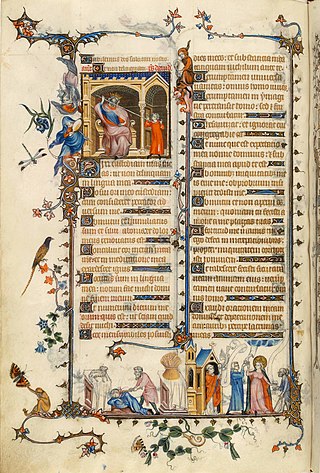
Jean Pucelle was a Parisian Gothic-era manuscript illuminator who excelled in the invention of drolleries as well as traditional iconography. He is considered one of the best miniaturists of the early 14th century. He worked primarily under the patronage of the royal court and is believed to have been responsible for the introduction of the arte nuovo of Giotto and Duccio to Northern Gothic art. His work shows a distinct influence of the Italian trecento art Duccio is credited with creating. His style is characterized by delicate figures rendered in grisaille, accented with touches of color.

Simon Bening was a Flemish miniaturist, generally regarded as the last major artist of the Netherlandish tradition.

Marie de Berry was suo jure Duchess of Auvergne and Countess of Montpensier in 1416–1434. She was the daughter of John, Duke of Berry, and Joanna of Armagnac. She was married three times. She acted as administrator of the Duchy of Bourbon for her third spouse John I, Duke of Bourbon, during his imprisonment in England after he was captured following the French defeat at the Battle of Agincourt in 1415, until 1434.
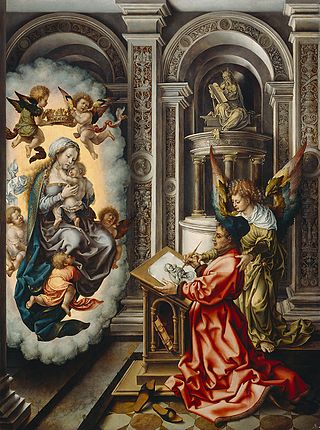
The Guild of Saint Luke was the most common name for a city guild for painters and other artists in early modern Europe, especially in the Low Countries. They were named in honor of the Evangelist Luke, the patron saint of artists, who was identified by John of Damascus as having painted the Virgin's portrait.

The Hours of Jeanne d'Evreux is an illuminated book of hours in the Gothic style. According to the usual account, it was created between 1324 and 1328 by Jean Pucelle for Jeanne d'Evreux, the third wife of Charles IV of France. It was sold in 1954 to the Metropolitan Museum of Art in New York where it is now part of the collection held at The Cloisters, and usually on display.
Jacquemart de Hesdin was a French miniature painter working in the International Gothic style. In English, he is also called Jacquemart of Hesdin. During his lifetime, his name was spelt in a number of ways, including as Jacquemart de Odin.

The Turin–Milan Hours is a partially destroyed illuminated manuscript, which despite its name is not strictly a book of hours. It is of exceptional quality and importance, with a very complicated history both during and after its production. It contains several miniatures of about 1420 attributed to an artist known as "Hand G" who was probably either Jan van Eyck, his brother Hubert van Eyck, or an artist very closely associated with them. About a decade or so later Barthélemy d'Eyck may have worked on some miniatures. Of the several portions of the book, that kept in Turin was destroyed in a fire in 1904, though black-and-white photographs exist.

André Beauneveu was an Early Netherlandish sculptor and painter, born in the County of Hainaut, who is best known for his work in the service of the French King Charles V, and of the Valois Duke, Jean de Berry. His work in all media shows a generally naturalistic and 'sculptural' style, characteristic of the 'Pucellian revival' of the latter 14th century.

The Petites Heures of Jean de France, Duc de Berry is an illuminated book of hours commissioned by John, Duke of Berry between 1375 and 1385–90. It is known for its ornate miniature leaves and border decorations.
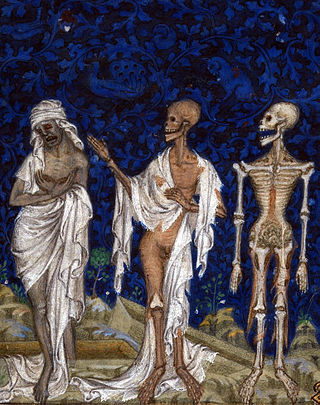
Jean Le Noir was a French manuscript illuminator active in Paris between 1335 and 1380. He was a pupil of Jean Pucelle. His main work is the Psalter of Bonne de Luxembourg.

A Goldsmith in His Shop is a 1449 painting by Petrus Christus, a leading painter in Bruges. It is now in the Metropolitan Museum of Art. This is an oil painting on an oak panel that measures 100.1 x 85.8 cm overall and the painted surface is 98 x 85.2 cm. An inscription at the bottom of the painting states "m petr[vs] xpi me· ·fecit·ao 1449· ". In addition, the inscription has an emblem of a clock with a mechanical linkage to a heart, Christus's emblem.
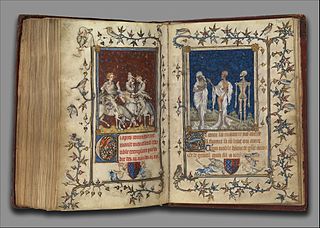
The Psalter of Bonne de Luxembourg is a small 14th-century illuminated manuscript in tempera, grisaille, ink and gold leaf on vellum. It is held in the collection of The Cloisters, New York, where it is usually on display.

The Pseudo-Jacquemart was an anonymous master illuminator active in Paris and Bourges between 1380 and 1415. He owed his name to his close collaboration with painter Jacquemart de Hesdin.

School of Paris refers to the many manuscript illuminators, whose identities are mostly unknown, who made Paris an internationally important centre of illumination throughout the Romanesque and Gothic periods of the Middle Ages, and for some time into the Renaissance. Among the most famous of these artists were Master Honoré, Jean Pucelle and Jean Fouquet.

The Hours of Jeanne de Navarre is an illuminated book of hours with miniatures painted by Jean Le Noir. The book was commissioned by Philip VI of Valois and his wife, Blanche de Navarre, for Jeanne de Navarre, Queen of Navarre. The book was created sometime between 1336 and 1340 and is now in the Bibliothèque Nationale, Paris.
References
- 1 2 3 4 5 Slatkin, Wendy (1985). Women Artists in History . New Jersey: Prentice-Hall. pp. 67, 68.
- ↑ "Brooklyn Museum: Bourgot". brooklynmuseum.org. Retrieved 2018-12-04.
- ↑ Sutherland Harris, Ann; Nochlin, Linda (1976). Women Artists: 1550-1950. New York: Random House. p. 19.
- 1 2 "The Prayer Book of Bonne of Luxembourg, Duchess of Normandy". metmuseum.org. Retrieved 2018-12-04.